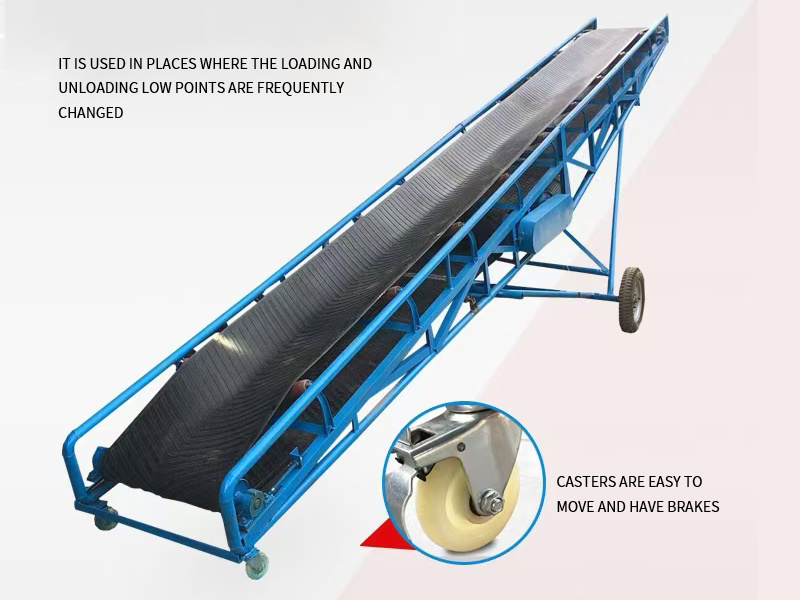Understanding Sidewall Belt Conveyors: Design, Functionality, and Applications
Oct 01,2025

Sidewall belt conveyors are specialized conveying systems designed to transport bulk materials at various inclines, often exceeding the limitations of standard flat belt conveyors. The unique design of sidewall conveyors incorporates vertical sidewalls that prevent material spillage and allow for steeper angles of inclination, making them particularly effective for moving materials in confined spaces or when dealing with challenging site layouts.
One of the standout features of sidewall belt conveyors is their ability to handle a wide range of materials, from granular substances like grains and fertilizers to larger bulk items such as coal and rocks. The sidewalls are typically made from durable rubber or plastic, which provides the necessary strength and flexibility while maintaining a lightweight structure. This construction allows for increased load capacity and efficiency compared to traditional conveyor systems.
In terms of functionality, sidewall belt conveyors operate using a series of pulleys and a continuous belt. The sidewalls are attached to the belt at regular intervals, creating compartments that securely hold the material as it is transported. This design minimizes the risk of material loss and enhances the overall reliability of the conveyor. Additionally, the belt can be equipped with cleats or profiles that further aid in material retention, especially on steep inclines.
The versatility of sidewall belt conveyors makes them suitable for a variety of applications across different industries. In the mining sector, they are commonly used for transporting ores and minerals. In logistics and distribution centers, they facilitate the movement of packaged goods, while in agricultural applications, they efficiently handle feed and fertilizers. Furthermore, they are increasingly utilized in recycling facilities, where they convey mixed materials for sorting and processing.
When considering the integration of sidewall belt conveyors into an operation, it’s essential to analyze the specific material characteristics, flow rates, and incline angles required for the application. Proper sizing and configuration of the system are critical to ensure optimal performance and longevity. Additionally, regular maintenance is necessary to address wear and tear, extending the lifespan of the conveyor and minimizing downtime.
In conclusion, sidewall belt conveyors represent an innovative solution for overcoming the challenges associated with material handling in various industrial environments. Their ability to operate at steep angles while securely transporting a wide range of materials makes them a valuable asset for any operation looking to enhance efficiency and reduce material loss. By understanding their design and functionality, businesses can make informed decisions on how to implement these conveyors to support their material handling needs.
One of the standout features of sidewall belt conveyors is their ability to handle a wide range of materials, from granular substances like grains and fertilizers to larger bulk items such as coal and rocks. The sidewalls are typically made from durable rubber or plastic, which provides the necessary strength and flexibility while maintaining a lightweight structure. This construction allows for increased load capacity and efficiency compared to traditional conveyor systems.
In terms of functionality, sidewall belt conveyors operate using a series of pulleys and a continuous belt. The sidewalls are attached to the belt at regular intervals, creating compartments that securely hold the material as it is transported. This design minimizes the risk of material loss and enhances the overall reliability of the conveyor. Additionally, the belt can be equipped with cleats or profiles that further aid in material retention, especially on steep inclines.
The versatility of sidewall belt conveyors makes them suitable for a variety of applications across different industries. In the mining sector, they are commonly used for transporting ores and minerals. In logistics and distribution centers, they facilitate the movement of packaged goods, while in agricultural applications, they efficiently handle feed and fertilizers. Furthermore, they are increasingly utilized in recycling facilities, where they convey mixed materials for sorting and processing.
When considering the integration of sidewall belt conveyors into an operation, it’s essential to analyze the specific material characteristics, flow rates, and incline angles required for the application. Proper sizing and configuration of the system are critical to ensure optimal performance and longevity. Additionally, regular maintenance is necessary to address wear and tear, extending the lifespan of the conveyor and minimizing downtime.
In conclusion, sidewall belt conveyors represent an innovative solution for overcoming the challenges associated with material handling in various industrial environments. Their ability to operate at steep angles while securely transporting a wide range of materials makes them a valuable asset for any operation looking to enhance efficiency and reduce material loss. By understanding their design and functionality, businesses can make informed decisions on how to implement these conveyors to support their material handling needs.
Hot Tags:
PREVIOUS:
Contact Us
E-mail:byunfei2000@gmail.com
Wechat/WhatsApp:+86 17324886663
WhatsApp:+86 18738568071
Address:No. 12 Industrial Road, Zhaipo Town, Xinxiang, Henan Province







